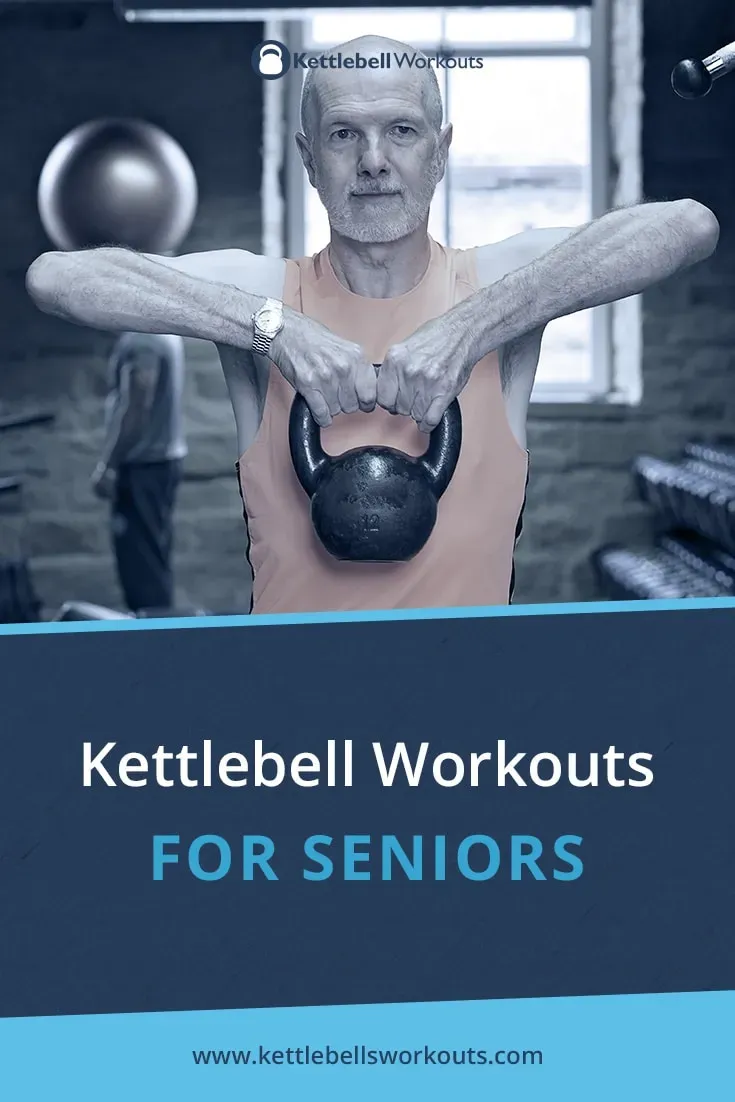Table of Contents
Maybe the gym scene feels intimidating. Or maybe you’ve seen those weird cannonball-looking weights and thought, "No way, that's for young folks tossing them around." It’s easy to think that building real strength or improving balance is something you should have started years ago. But here's a little secret: it's absolutely not too late. In fact, introducing resistance training can make a massive difference in how you feel and move daily.
Why a Kettlebell Workout for Senior Beginners?

Why a Kettlebell Workout for Senior Beginners?
More Than Just Building Muscle
Let's be honest, nobody is expecting you to suddenly look like a bodybuilder from 1970. That's not the goal here, and frankly, it's an unrealistic one for most people, regardless of age. The real win with resistance training, especially as you get older, is maintaining what you've got and improving function. We're talking about making everyday tasks easier – carrying groceries, getting up from a low chair, playing with grandkids without feeling completely wiped out. Muscle mass naturally declines with age, a delightful process called sarcopenia. Fighting that decline isn't about vanity; it's about maintaining independence and quality of life.
Ignoring strength training means accepting that things will get harder. Stairs become more of a challenge, opening jars feels like a Herculean task, and the risk of falls increases as balance and leg strength diminish. A consistent, smart approach to lifting, even just a couple of times a week, acts as a powerful defense against these age-related declines. It's an investment in your future mobility and capability. So, asking "Why a kettlebell workout for senior beginners?" is really asking "Why invest in moving better and staying stronger?"
The Kettlebell's Unique Advantage
so why a kettlebell specifically? Why not just use dumbbells or resistance bands? While those have their place, the kettlebell has a few tricks up its sleeve, particularly beneficial for senior beginners. Its center of mass is offset from the handle. This might sound like technical jargon, but it means the weight pulls differently than a dumbbell. This forces smaller stabilizing muscles to work harder, especially around your wrists, shoulders, and core. Think of it as integrated strength training; your body works as a unit, not just isolated muscles.
This unique design is fantastic for improving grip strength, which is often one of the first things to go and is surprisingly important for overall health and longevity markers. It also lends itself beautifully to movements that mimic real life – lifting things off the floor, swinging a weight safely, or carrying something. These aren't static, machine-based motions; they are dynamic, functional movements that translate directly to navigating your world with more ease and less risk of injury. Plus, the handle shape is often more comfortable for many people to grip securely compared to a thick dumbbell handle.
- Improves grip strength significantly.
- Enhances balance and stability due to the offset weight.
- Works multiple muscle groups simultaneously.
- Teaches your body to move functionally, like lifting and carrying.
- Can help improve joint mobility through dynamic movements.
Beyond the Traditional Weights
Unlike barbells that require two hands in a fixed position or dumbbells that are often used for more isolated exercises, the kettlebell encourages fluid, compound movements. This is perfect for senior beginners because it allows you to get more bang for your buck in a shorter workout time. You're not just working a bicep; you're potentially involving your legs, core, back, and grip all in one go, depending on the exercise.
Think about a simple kettlebell deadlift compared to a machine leg press. The deadlift requires balance, coordination, and engages your entire posterior chain (back, glutes, hamstrings) in a way that's directly applicable to picking something up off the floor. The leg press is useful for building quad strength but does little for your balance or the coordination needed for lifting. This functional aspect is a key reason why a kettlebell workout for senior beginners is so effective at building practical strength that you can actually use.
Choosing Your First Kettlebell and Prioritizing Safety

Choosing Your First Kettlebell and Prioritizing Safety
Picking the Right Weight Isn't Rocket Science
let's talk about that first kettlebell. Don't march into a sporting goods store and grab the biggest one you can lift an inch off the floor. That's a fast track to pulling something important. For a kettlebell workout for senior beginners, starting light is not being timid; it's being smart. Most resources suggest women start with around 4-6 kg (that's roughly 9-13 lbs) and men with 8-12 kg (about 18-26 lbs). This might feel *too* light when you first pick it up, but remember, kettlebell movements are often dynamic. That seemingly light weight gets much heavier when you're swinging it or holding it away from your body.
Think about the movements you'll do first: things like deadlifts, goblet squats, and maybe some gentle swings. You need to be able to control the weight through the entire range of motion without your form falling apart. If you're struggling to even hold the weight properly, it's too heavy. It's far better to start lighter, master the technique, and then move up gradually. Your ego might want the heavier one, but your joints will thank you for starting conservative.
Safety First, Always
Before you even think about swinging anything, we need to drill down on safety. This isn't optional, it's the foundation of your entire kettlebell workout for senior beginners journey. First off, clear your space. Tripping over the dog or a rug while holding a heavy object is a guaranteed bad time. Wear appropriate footwear – no slippers or bare feet. You need stability.
Learn the basic movements *without* the kettlebell first. Practice the hip hinge (how to bend properly at your hips, not your back) until it feels natural. Watch videos from reputable sources. Consider a session or two with a trainer familiar with kettlebells and working with older adults. Getting the form right from the start prevents ingrained bad habits that are tough to break and significantly reduces injury risk. Remember, pain is not gain; pain is your body telling you to stop doing that.
- Always warm up for 5-10 minutes before lifting.
- Focus on form over the number of reps or weight.
- Listen to your body; if something hurts sharply, stop.
- Stay hydrated during your workout.
- Cool down with gentle stretching afterward.
Checking Your Form
How do you actually know if your form is decent? A mirror helps, but a video recording is even better. Set up your phone and film yourself from the side and front. You might be surprised by what you see (and what you thought you were doing versus reality). Compare your video to instructional videos from trusted coaches.
Another crucial aspect is breathing. Don't hold your breath. Exhale during the exertion phase of the lift (e.g., as you stand up in a squat or deadlift). This helps manage blood pressure and ensures your muscles get the oxygen they need. Taking the time to learn proper form and prioritize safety makes your kettlebell workout for senior beginners effective and sustainable.
Key Kettlebell Exercises for Senior Beginners

Key Kettlebell Exercises for Senior Beginners
Starting with the Basics: The Deadlift and Goblet Squat
Alright, let's get down to brass tacks: what do you actually *do* with this thing? For a kettlebell workout for senior beginners, you start simple. The kettlebell deadlift is your absolute foundation. It’s essentially just picking the weight up off the floor correctly, using your hips and legs, not your back. Stand with your feet hip-width apart, the kettlebell between your feet. Hinge at your hips, keeping your back straight, grab the handle, and stand up tall, squeezing your glutes at the top. Lower it back down the same way. This movement is crucial for real life – picking up groceries, laundry baskets, or even a grandkid.
Next up is the goblet squat. Hold the kettlebell by the horns (the sides of the handle) against your chest. Stand with your feet slightly wider than hip-width, toes pointed slightly out. Squat down by pushing your hips back and bending your knees, keeping your chest up and back straight. Go as low as you can comfortably, ideally until your thighs are parallel to the floor, then stand back up. Holding the weight in front helps counterbalance you, often making it easier to maintain an upright posture compared to a barbell or even bodyweight squats for some.
Adding a Little Movement: The Kettlebell Swing and Row
Once you've got the deadlift down, you can progress to the kettlebell swing. This is where the unique nature of the kettlebell really shines, but it requires mastering that hip hinge first. Stand with the kettlebell slightly in front of you. Hinge at your hips, grabbing the handle with both hands. Hike the kettlebell back between your legs (like snapping a football) and then forcefully extend your hips and knees to stand up, letting the momentum swing the kettlebell up to chest height. It's a powerful, dynamic movement that works your entire posterior chain. Remember, it's a hip hinge, not a squat or an arm lift.
Another excellent exercise for a beginner kettlebell workout for senior beginners is the single-arm row. You can do this supported (hand on a bench or chair) or unsupported if your core is strong enough. Hinge at your hips, letting the kettlebell hang towards the floor. Pull the kettlebell up towards your rib cage, squeezing your shoulder blade at the top, then lower it back down with control. This builds upper back strength, essential for good posture and counteracting all that time spent hunched over reading or watching TV.
Exercise | Primary Focus | Key Benefit for Seniors |
|---|---|---|
Kettlebell Deadlift | Hips, Hamstrings, Back | Improves ability to lift objects from the floor safely. |
Goblet Squat | Quads, Glutes, Core | Enhances lower body strength for standing and sitting. |
Kettlebell Swing | Hips, Glutes, Core, Back | Develops explosive power and strengthens posterior chain. |
Single-Arm Row | Upper Back, Biceps | Builds pulling strength and improves posture. |
Designing Your Kettlebell Workout for Senior Beginners Routine

Designing Your Kettlebell Workout for Senior Beginners Routine
Starting Simple and Staying Consistent
so you've got your kettlebell (the right weight, hopefully!), you know the basic moves like the deadlift and goblet squat, maybe even a gentle swing. Now what? How do you actually turn these pieces into a routine? The biggest mistake I see people make, young or old, is trying to do too much too soon. For a kettlebell workout for senior beginners, consistency beats intensity every single time. Aim for two, maybe three, non-consecutive days a week. That means having a rest day in between your workouts so your body can recover and build strength.
Don't feel pressured to do every exercise you ever see on YouTube. Start with the foundational movements we discussed – the deadlift, the goblet squat, maybe the row. Pick 3-4 exercises you feel comfortable with. Doing a few exercises well is infinitely better than doing a dozen poorly. Your first few sessions might just be practicing the movements with a very light weight or even no weight at all. That's perfectly fine. You're building the movement pattern, which is the critical first step. Think of it as laying the groundwork for a sturdy building.
Structuring Your Weekly Sessions
Once you're comfortable with the movements, you can start thinking about sets and reps. For building strength and improving function, aiming for 2-3 sets of 8-12 repetitions per exercise is a solid starting point for your kettlebell workout for senior beginners. If 12 reps feel too easy while maintaining good form, that's your cue that maybe it's time to consider going up in weight on your next kettlebell purchase, not doing 20 messy reps.
Give yourself adequate rest between sets, perhaps 60-90 seconds. This isn't a race. The goal is quality movement. As you get stronger, you might find you need less rest, or you might be able to do more reps or sets. Progress is gradual, often measured in small increments over weeks and months, not overnight transformations. Keep a simple log – even just notes on your phone – of what exercises you did, the weight used, and how many reps. It helps you see your progress and plan future workouts. It’s like tracking your steps, but for strength.
- Aim for 2-3 workouts per week.
- Allow a rest day between sessions.
- Choose 3-4 foundational exercises to start.
- Perform 2-3 sets per exercise.
- Aim for 8-12 repetitions per set.
- Rest 60-90 seconds between sets.
- Track your progress (exercises, weight, reps).
Smart Tips for Your Kettlebell Workout for Senior Beginners

Smart Tips for Your Kettlebell Workout for Senior Beginners
Listen to Your Body, Not Your Ego
Look, it's easy to get caught up in wanting to lift heavier or do more reps than last time, or more than the person you saw on that fitness video. But the smartest thing you can do with your kettlebell workout for senior beginners is pay attention to what your body is telling you. Soreness is one thing – a dull ache in the muscles that tells you they did some work. Pain is different. Sharp, joint pain, or something that feels 'wrong' isn't just a signal; it's a stop sign. Pushing through pain is how minor issues become major setbacks that keep you from exercising at all.
There will be days you feel fantastic and could probably lift a small car (don't try this). There will also be days you feel stiff, tired, or just not "on." On those days, it's okay to reduce the weight, do fewer reps, or even just focus on mobility work instead of lifting. Consistency over time builds strength, not grinding yourself into dust on one bad day. Think of it like managing a budget; sometimes you can splurge, but you can't do it every day without consequences.
Consistency Trumps Intensity (and Get Help If You Need It)
Getting stronger and more confident with your kettlebell workout for senior beginners isn't about hitting beast mode once a month. It's about showing up consistently, even when you don't feel like it. Two or three solid workouts a week, week after week, will yield far better results than one massive session followed by two weeks of recovery. Life happens, sure, but aim for that regular rhythm. It's the steady drip that fills the bucket.
Also, don't be afraid to ask for help. Seriously. Trying to figure out a complex movement like the kettlebell swing solely from watching a video can be like learning to drive by watching NASCAR – inspiring maybe, but potentially hazardous without hands-on guidance. A few sessions with a qualified trainer who understands kettlebells and working with older adults can be invaluable. They can check your form, help you pick the right weight, and make sure you're building a routine that's safe and effective for *you*. It's an investment in doing things right from the start.
- Prioritize proper form over lifting heavy weight.
- Don't ignore pain; differentiate it from muscle soreness.
- Adjust your workout based on how you feel each day.
- Aim for consistent workouts (2-3 times/week).
- Consider professional coaching to learn correct technique.
- Be patient; progress takes time and consistency.
Your Kettlebell Journey Starts Now
So there you have it. Starting a kettlebell workout for senior beginners isn't about becoming a powerlifter overnight. It's about adding a powerful tool to your fitness arsenal that can genuinely improve your daily life – making lifting groceries easier, walking more stable, and generally feeling more capable. Remember, consistency trumps intensity, especially when you're just starting out. Don't get hung up on perfect form from day one; focus on learning the movements safely with a light weight. Your progress might feel slow initially, but stick with it. The payoff in strength, balance, and confidence is real. Pick up that first kettlebell, take it slow, and see what you can do.